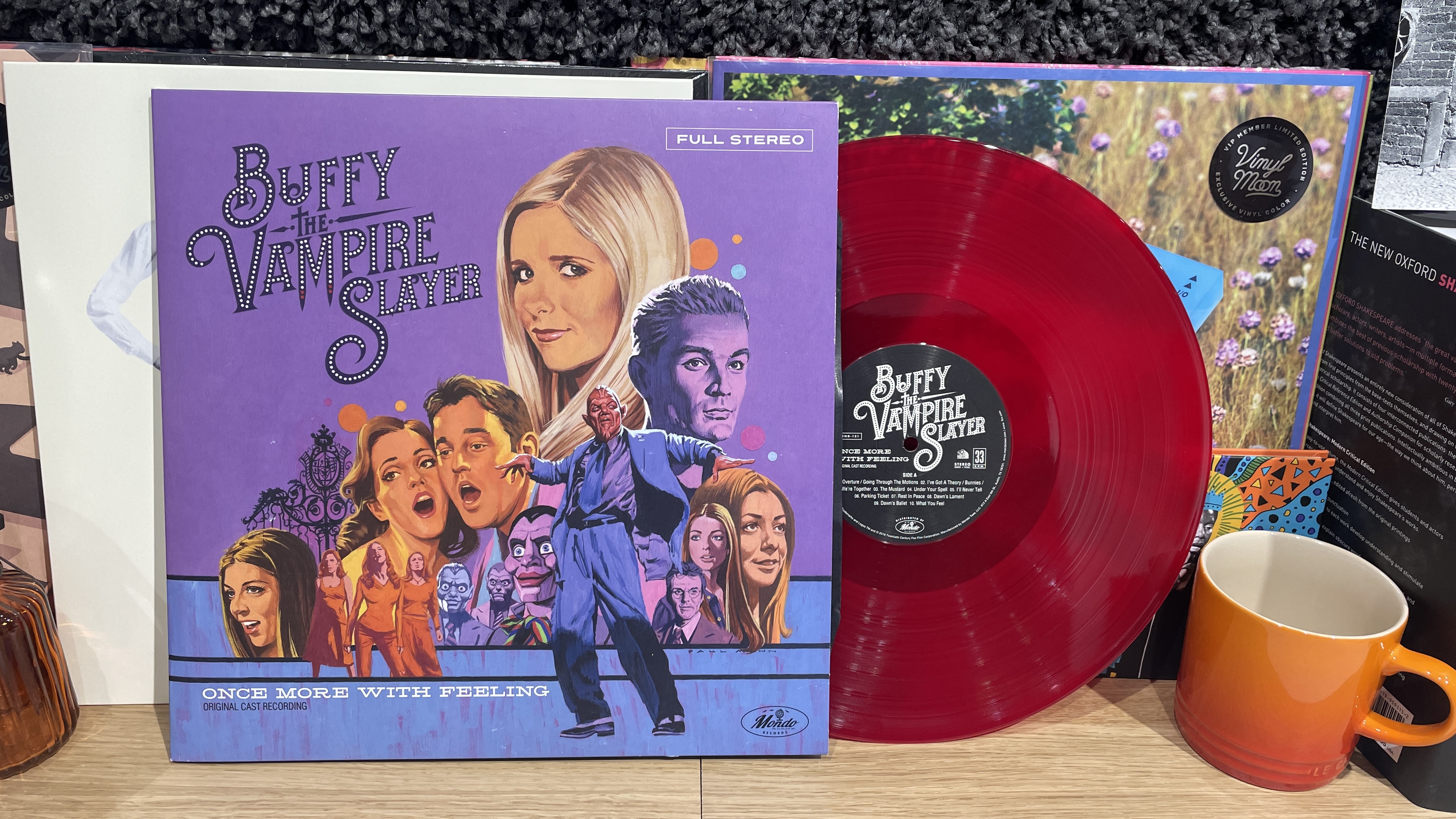Cassette Store Day: a look back to 1985 and the blank tape's heyday
Remember when cassettes were the future of music?
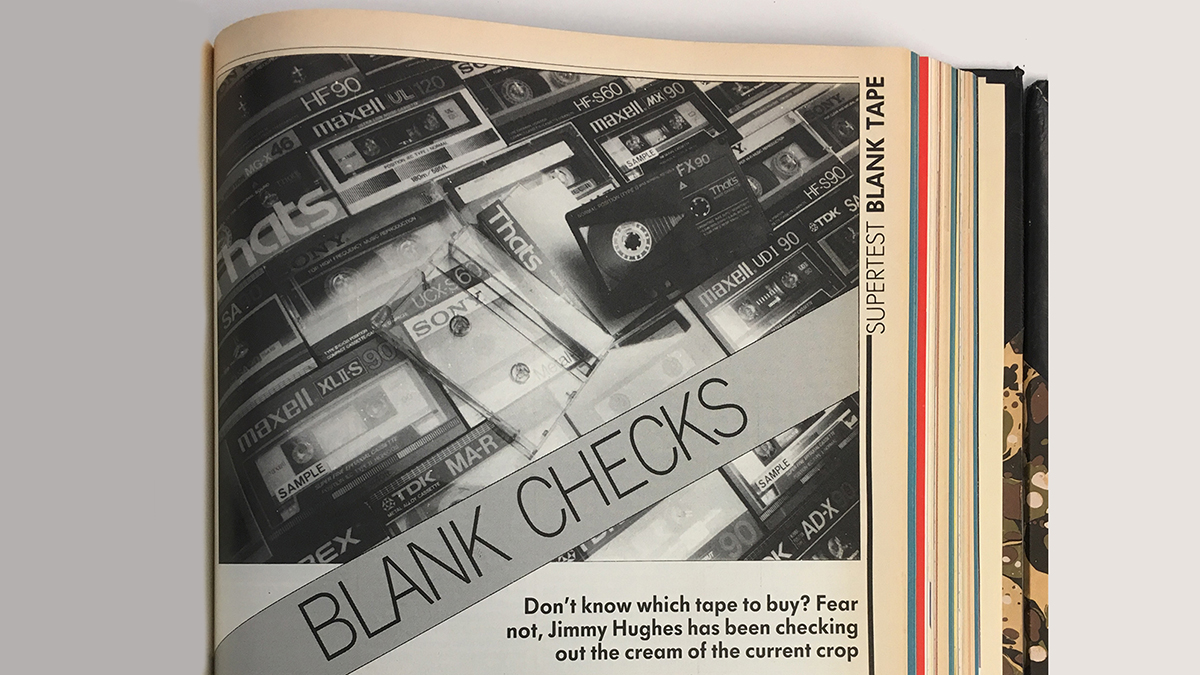
Yes, Cassette Store Day is a thing – and actually, that's not at all unjust considering tape sales are the highest they've been since 2004. Inspired by the popularity of Record Store Day, Cassette Store Day was concocted in 2013 to celebrate yet another retro format.
But whereas the vinyl revival maintains a continued resurgence – with new turntables being produced every year and vinyl LP sales reaching 4.1 million in 2017 – cassette tapes haven't made quite the same roaring comeback... yet. Will 2020 be the year?
Sales of cassette tapes doubled in the UK in 2017, 18,500 tapes were sold during the first half of 2018, and this year sales are already over 36,000. It's not loads, of course, but it's a surprising amount for a once-dead format.
Invented by Philips in 1962, the compact cassette tape was originally meant for dictaphone use rather than hi-fi audio, but it quickly became the go-to analogue format of its time thanks to a mix of convenience, compact size and, of course, the ability to make mixtapes by recording music on to the tapes yourself.
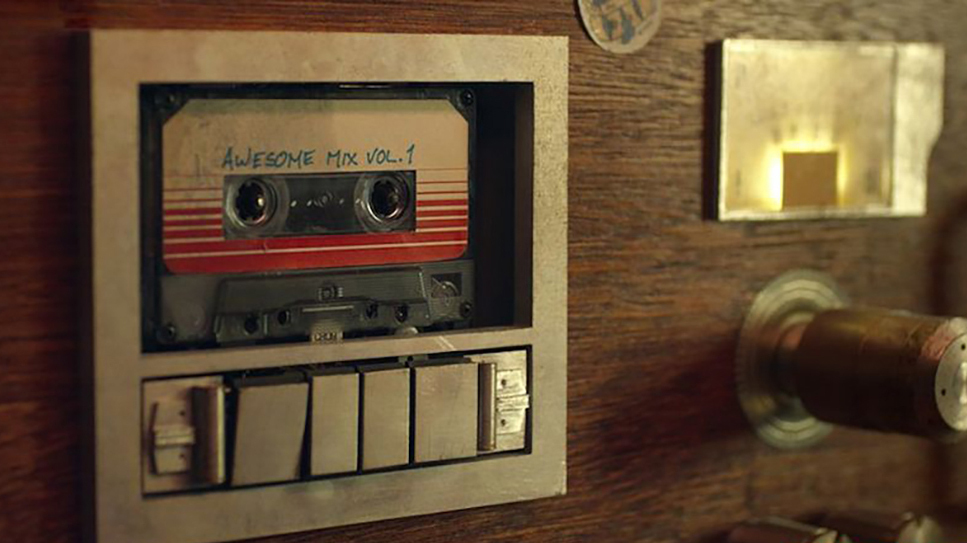
Recent movies such as Marvel's Guardians of the Galaxy (2014, 2017) heavily featured the original Sony Walkman and mixtapes (the soundtracks were also released on cassette) and trendy high street shops like Urban Outfitters are now stocking cassettes and faux-Walkmans alongside its vinyl LPs. Sony has recently announced a retro Walkman, the £400 NW-A100TPS, to mark the iconic portable cassette player's 40th anniversary this year. And even artist newcomers are seeing some value in the format, with Billie Eilish's When We All Fall Asleep, Where Do We Go? album having shifted 4000 copies alone this year.
It's no wonder, then, that the cassette tape is currently enjoying a boost in popularity.
While Cassette Store Day (now in its seventh year and taking place on October 12th) is nowhere near as large a celebration as Record Store Day, it did make us nostalgic for the days when cassette tapes were the main way to listen to music.
Get the What Hi-Fi? Newsletter
The latest hi-fi, home cinema and tech news, reviews, buying advice and deals, direct to your inbox.
So we dug into our archives to the hi-fi heydays of the 80s and 90s when we used to test and review blank cassette tapes. That's right: Blank. Cassette. Tapes.
See the galleries below:
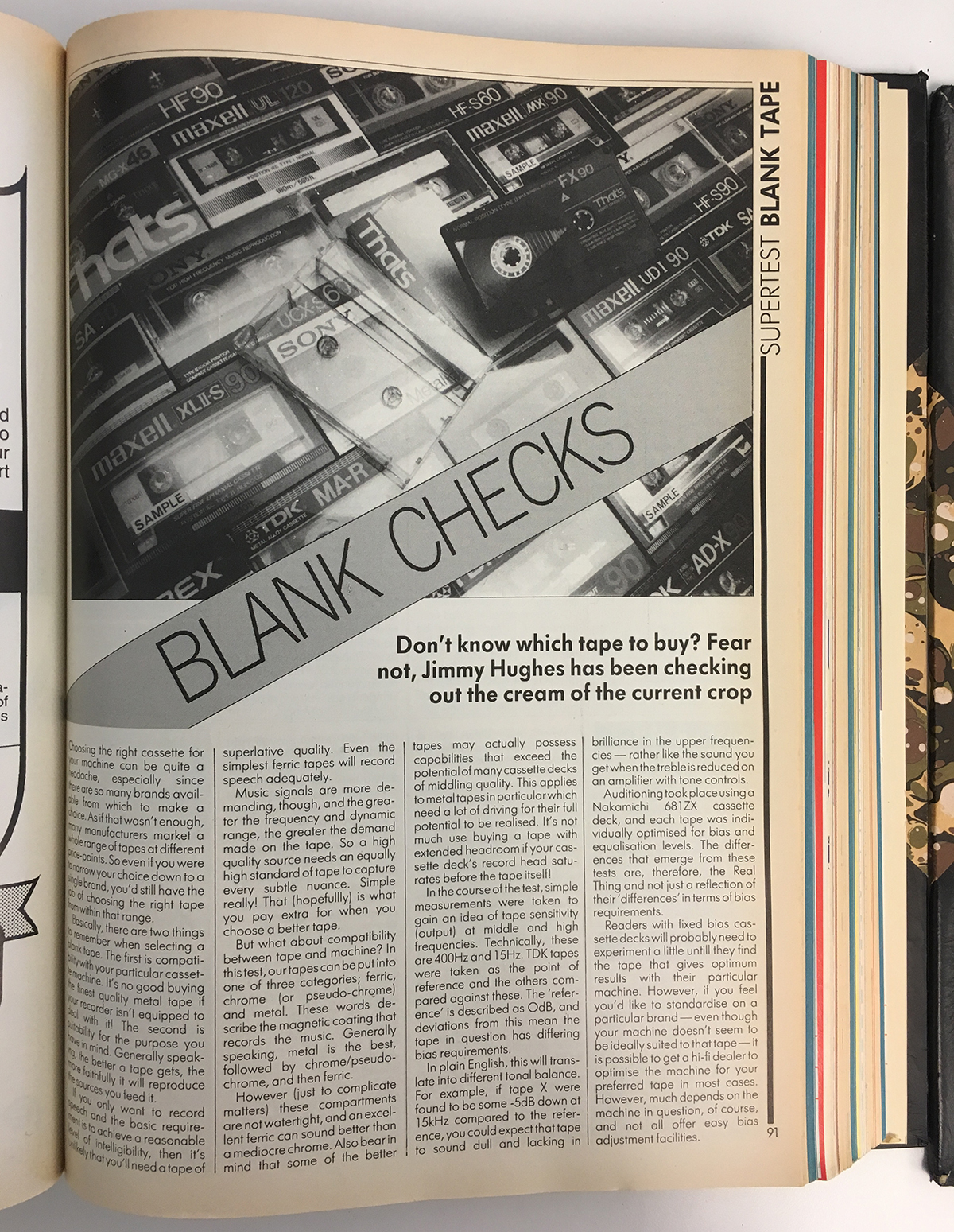
Blank cassette tape supertest - What Hi-Fi?, October 1985
This 28-strong supertest from 1985 featured tapes from manufacturers such as BASF, Maxell, Memorex, Sony, TDK and That's - all tested using a Nakamichi 681ZX cassette deck.
"In this test, our tapes can be put into one of three categories: ferric, chrome (or pseudo-chrome) and metal. These words describe the magnetic coating that records the music. Generally speaking, metal is the best, followed by chrome/pseudo-chrome, and then ferric."
We also note that it's important to make sure your chosen tape is compatible with your particular cassette deck, and that your purpose suits the tape. For instance, the simplest ferric tapes will record speech adequately, but music signals are more demanding - "so a high quality source needs an equally high standard of tape to capture every subtle nuance."
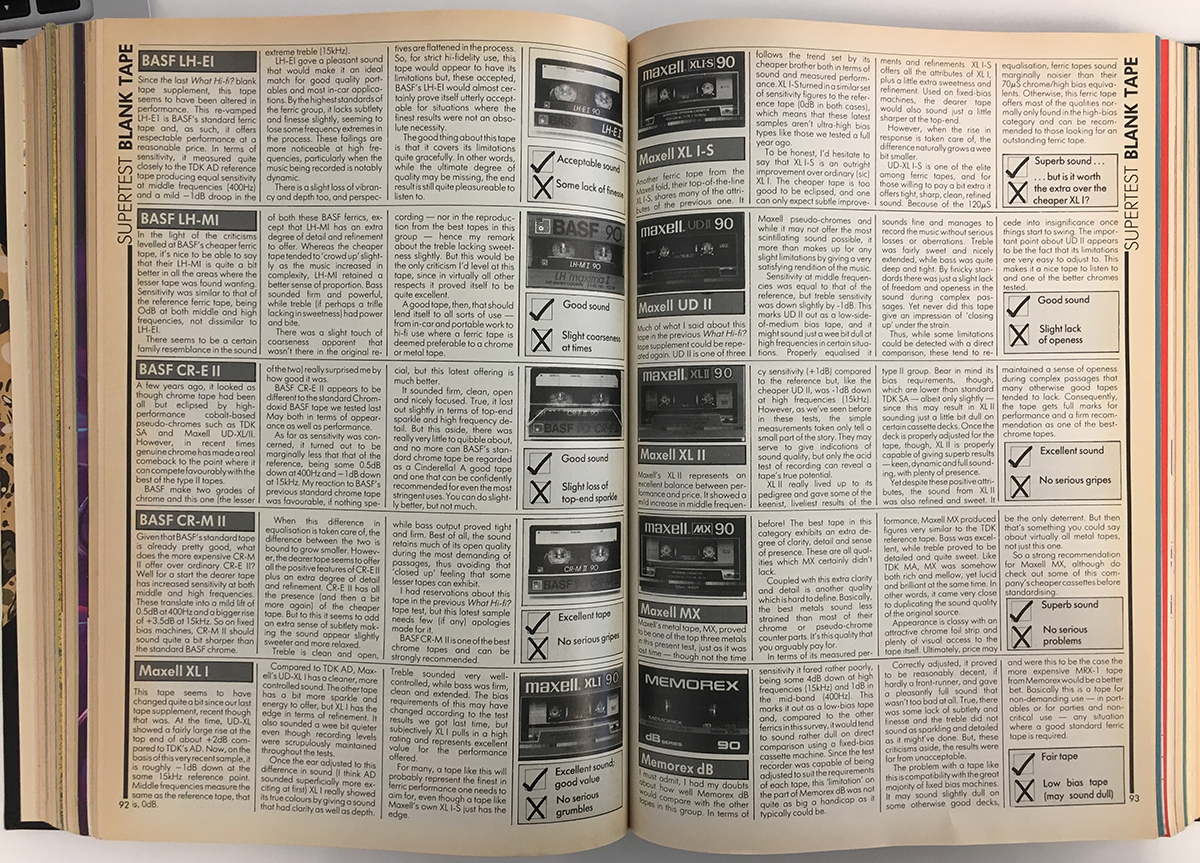
Blank cassette tape supertest - What Hi-Fi?, October 1985
This 28-strong supertest from 1985 featured tapes from manufacturers such as BASF, Maxell, Memorex, Sony, TDK and That's - all tested using a Nakamichi 681ZX cassette deck.
"In this test, our tapes can be put into one of three categories: ferric, chrome (or pseudo-chrome) and metal. These words describe the magnetic coating that records the music. Generally speaking, metal is the best, followed by chrome/pseudo-chrome, and then ferric."
We also note that it's important to make sure your chosen tape is compatible with your particular cassette deck, and that your purpose suits the tape. For instance, the simplest ferric tapes will record speech adequately, but music signals are more demanding - "so a high quality source needs an equally high standard of tape to capture every subtle nuance."

Blank cassette tape supertest - What Hi-Fi?, October 1985
This 28-strong supertest from 1985 featured tapes from manufacturers such as BASF, Maxell, Memorex, Sony, TDK and That's - all tested using a Nakamichi 681ZX cassette deck.
"In this test, our tapes can be put into one of three categories: ferric, chrome (or pseudo-chrome) and metal. These words describe the magnetic coating that records the music. Generally speaking, metal is the best, followed by chrome/pseudo-chrome, and then ferric."
We also note that it's important to make sure your chosen tape is compatible with your particular cassette deck, and that your purpose suits the tape. For instance, the simplest ferric tapes will record speech adequately, but music signals are more demanding - "so a high quality source needs an equally high standard of tape to capture every subtle nuance."
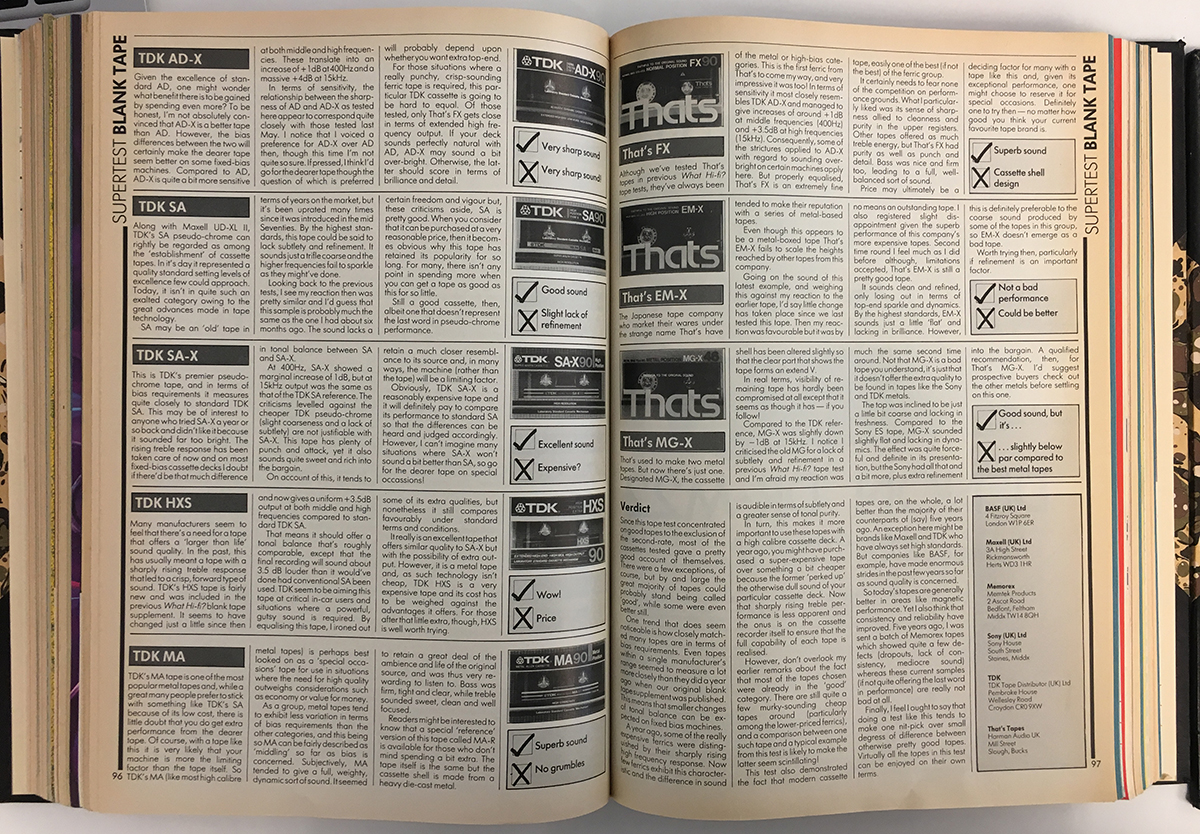
Blank cassette tape supertest - What Hi-Fi?, October 1985
This 28-strong supertest from 1985 featured tapes from manufacturers such as BASF, Maxell, Memorex, Sony, TDK and That's - all tested using a Nakamichi 681ZX cassette deck.
"In this test, our tapes can be put into one of three categories: ferric, chrome (or pseudo-chrome) and metal. These words describe the magnetic coating that records the music. Generally speaking, metal is the best, followed by chrome/pseudo-chrome, and then ferric."
We also note that it's important to make sure your chosen tape is compatible with your particular cassette deck, and that your purpose suits the tape. For instance, the simplest ferric tapes will record speech adequately, but music signals are more demanding - "so a high quality source needs an equally high standard of tape to capture every subtle nuance."
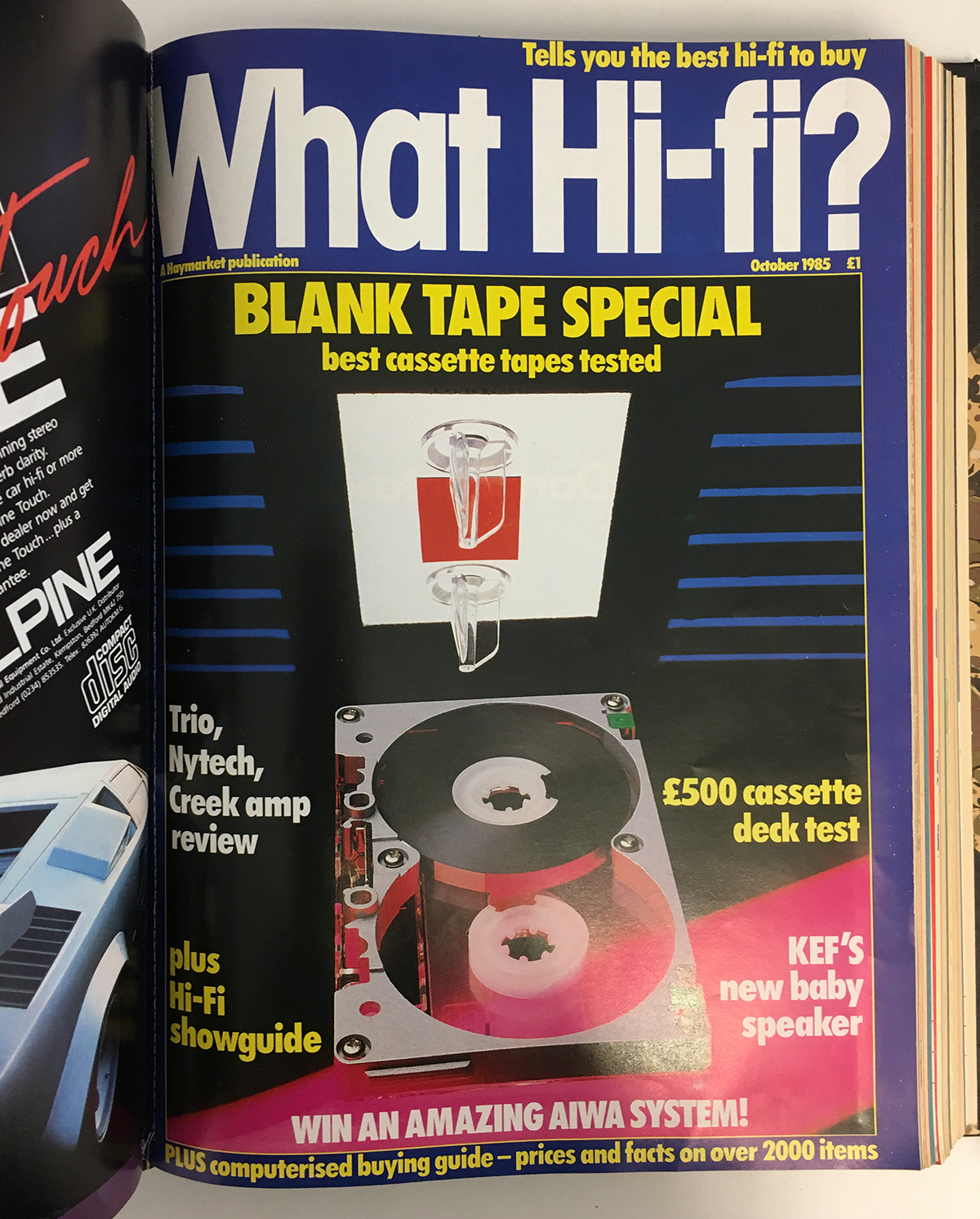
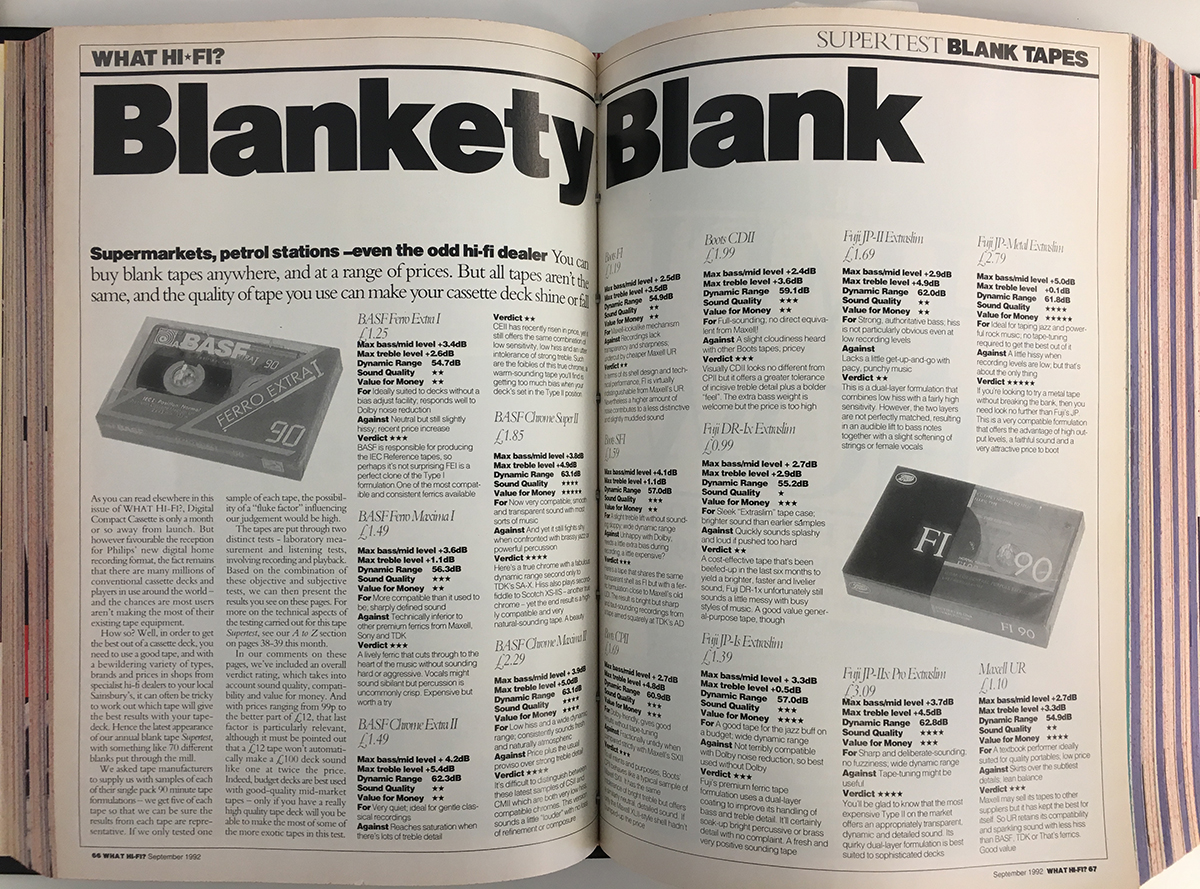
Blank cassette tape supertest - What Hi-Fi?, September 1992
Out of the 70 (70!) blank cassette tapes tested here in the September 1992 issue, the standout option is the TDK SA-X.
For £2.36, it boasted "the widest dynamic range of any tape... the powerful and pin-sharp sound of SA-X makes it an ideal choice for the enthusiast. A natural partner for the exotic Nakamichis out there in hi-fi land."
The tapes in this supertest were given an overall rating that took into account sound quality, compatibility and value for money, with prices ranging from 99p to £12.
We were also extremely rigorous in our testing: "We asked tape manufacturers to supply us with samples of each of their single pack 90 minute tape formulations - we get five of each tape so we can be sure the results from each tape are representative. If we only tested only one sample of each tape, the possibility of a 'fluke factor' influencing our judgement would be high."
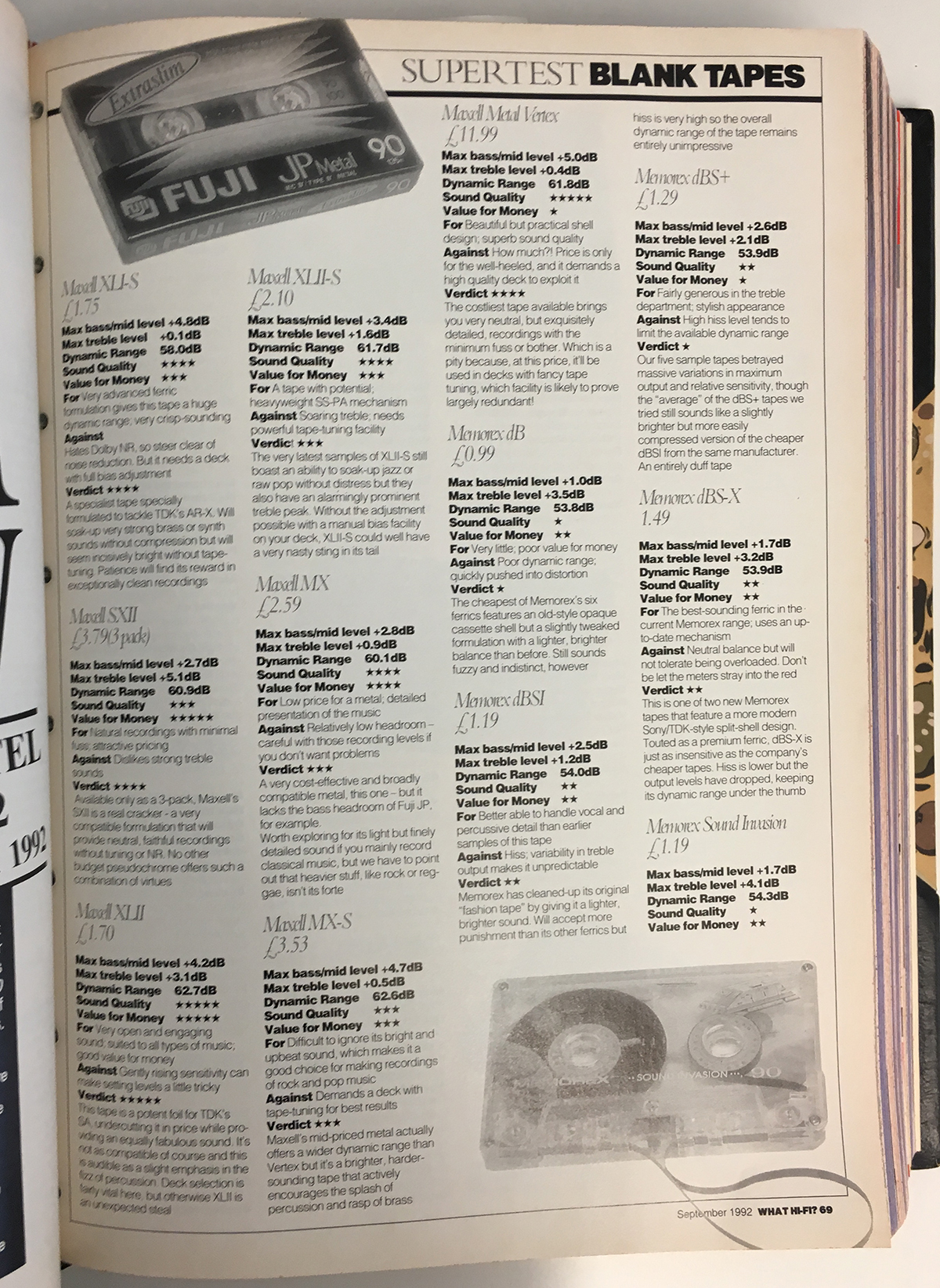
Blank cassette tape supertest - What Hi-Fi?, September 1992
Out of the 70 (70!) blank cassette tapes tested here in the September 1992 issue, the standout option is the TDK SA-X.
For £2.36, it boasted "the widest dynamic range of any tape... the powerful and pin-sharp sound of SA-X makes it an ideal choice for the enthusiast. A natural partner for the exotic Nakamichis out there in hi-fi land."
The tapes in this supertest were given an overall rating that took into account sound quality, compatibility and value for money, with tapes ranging from 99p to £12.
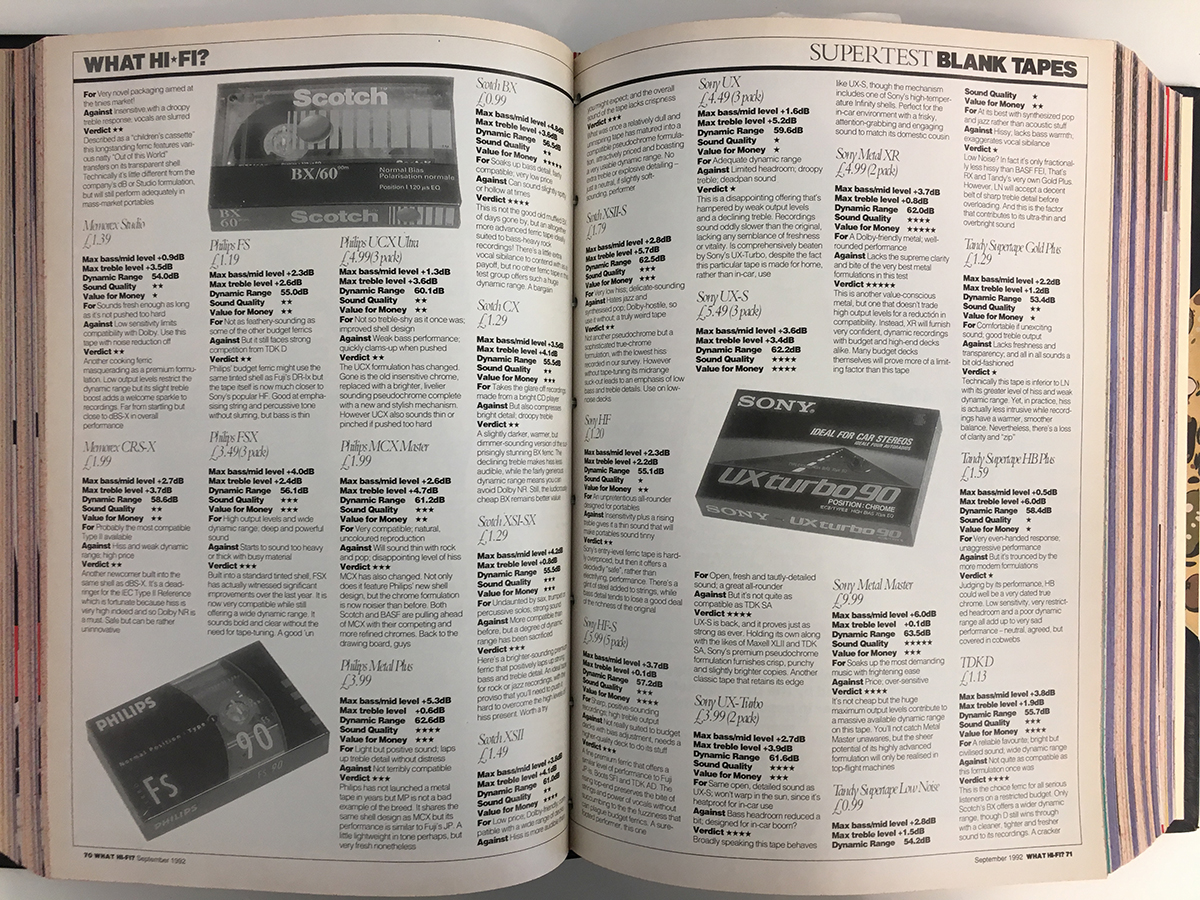
Blank cassette tape supertest - What Hi-Fi?, September 1992
Out of the 70 (70!) blank cassette tapes tested here in the September 1992 issue, the standout option is the TDK SA-X.
For £2.36, it boasted "the widest dynamic range of any tape... the powerful and pin-sharp sound of SA-X makes it an ideal choice for the enthusiast. A natural partner for the exotic Nakamichis out there in hi-fi land."
The tapes in this supertest were given an overall rating that took into account sound quality, compatibility and value for money, with tapes ranging from 99p to £12.
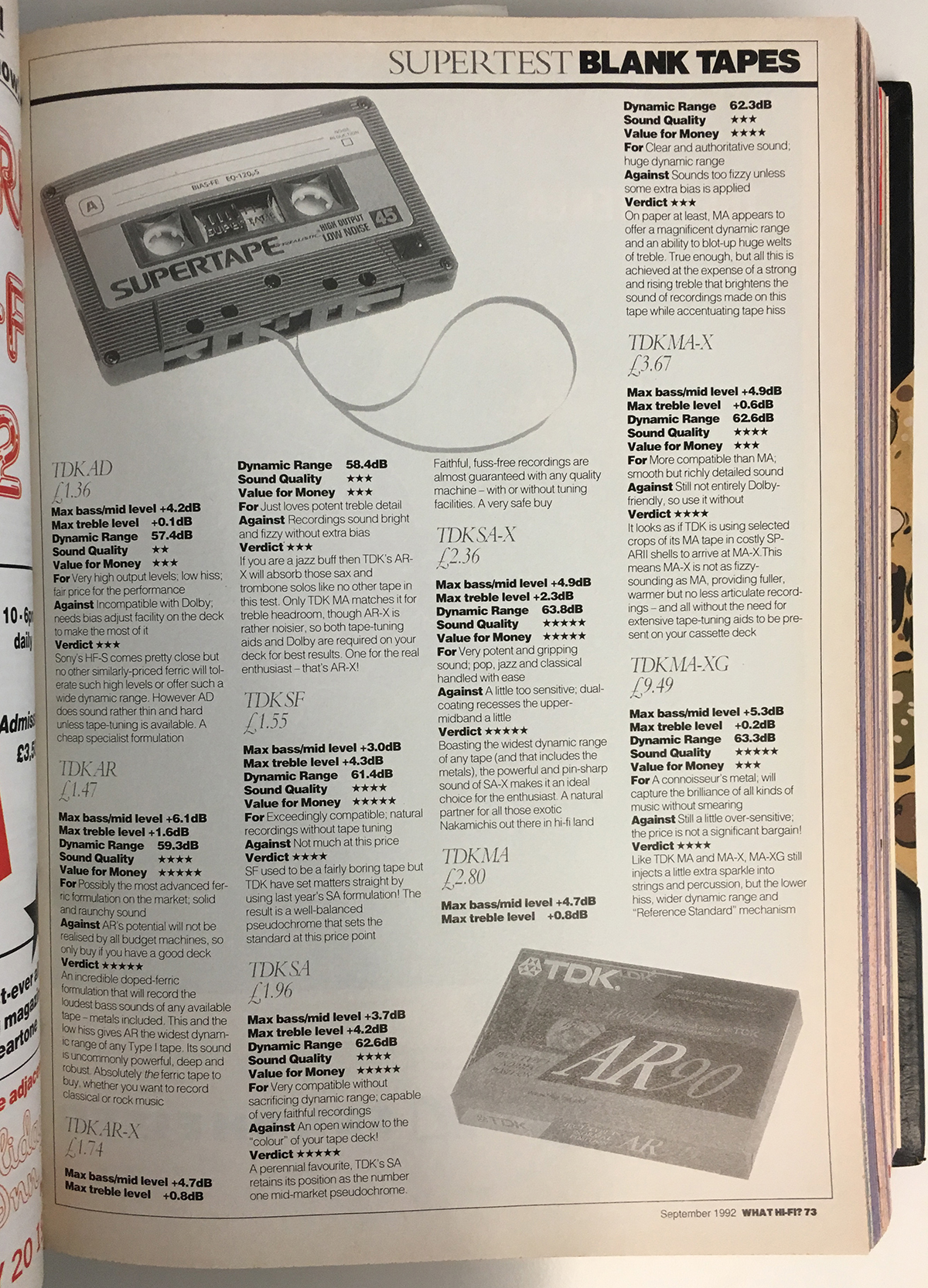
Blank cassette tape supertest - What Hi-Fi?, September 1992
Out of the 70 (70!) blank cassette tapes tested here in the September 1992 issue, the standout option is the TDK SA-X.
For £2.36, it boasted "the widest dynamic range of any tape... the powerful and pin-sharp sound of SA-X makes it an ideal choice for the enthusiast. A natural partner for the exotic Nakamichis out there in hi-fi land."
The tapes in this supertest were given an overall rating that took into account sound quality, compatibility and value for money, with tapes ranging from 99p to £12.
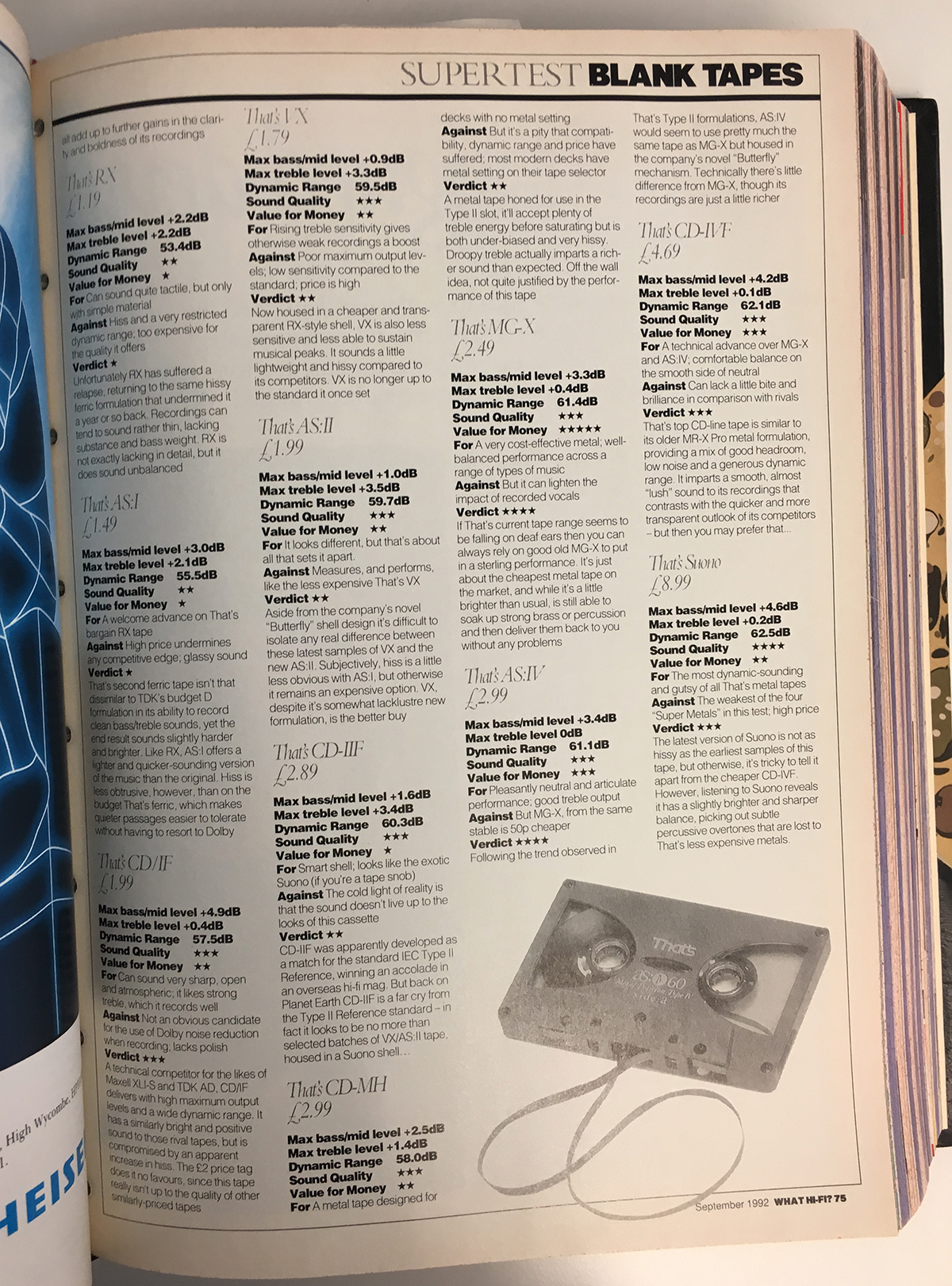
Blank cassette tape supertest - What Hi-Fi?, September 1992
Out of the 70 (70!) blank cassette tapes tested here in the September 1992 issue, the standout option is the TDK SA-X.
For £2.36, it boasted "the widest dynamic range of any tape... the powerful and pin-sharp sound of SA-X makes it an ideal choice for the enthusiast. A natural partner for the exotic Nakamichis out there in hi-fi land."
The tapes in this supertest were given an overall rating that took into account sound quality, compatibility and value for money, with tapes ranging from 99p to £12.
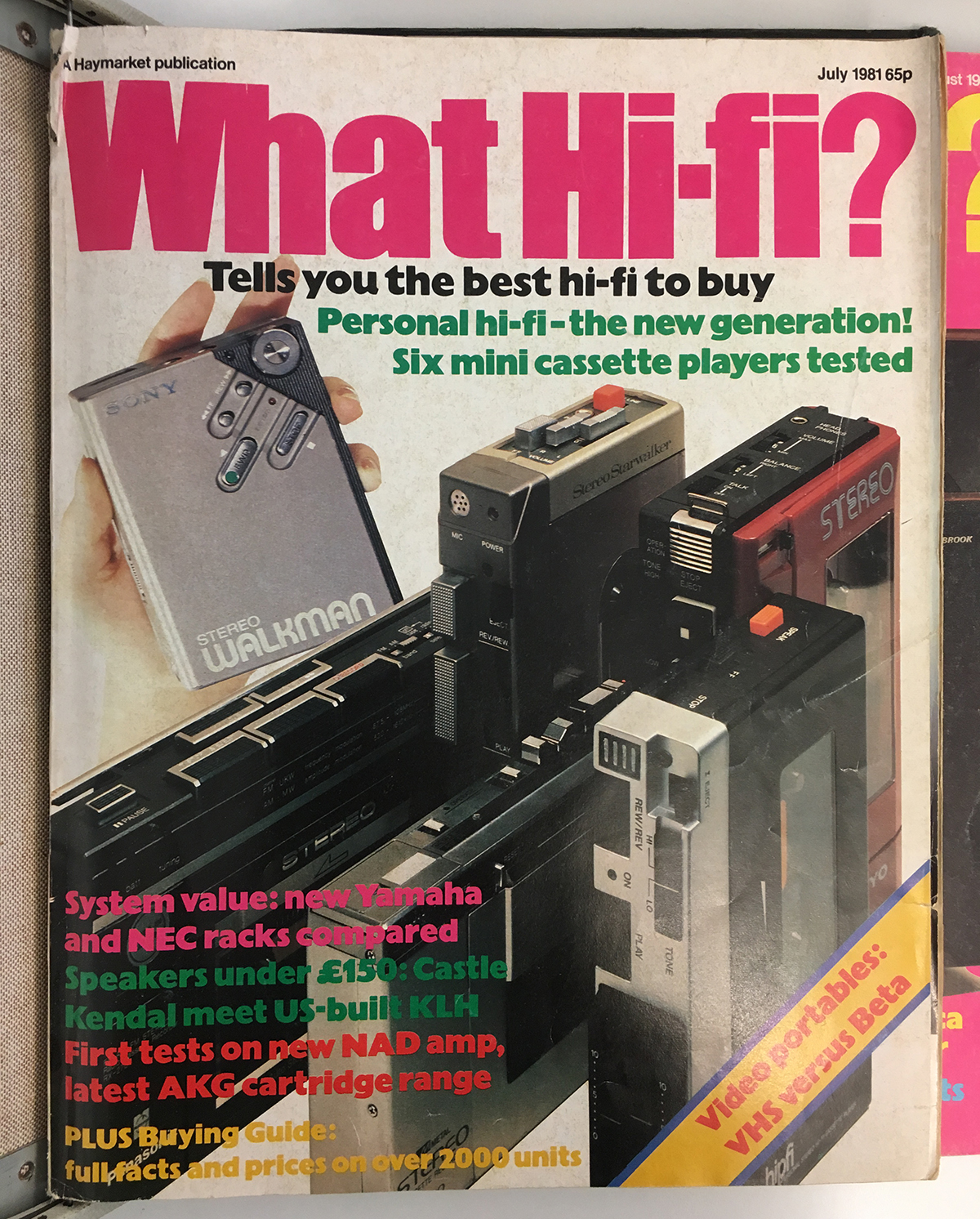
Alongside the tapes were hi-fi cassette decks - the pinnacle of which was the Nakamichi Dragon - and the iconic Sony Walkman TPS-L2, the granddaddy of portable music players and a firm fixture in pop culture.
Sony started the personal stereo craze with the Walkman's introduction in 1979, and it's no stretch to say that the MP3 players and hi-res portable music players of today can trace their lineage back to this compact blue and silver box.
The original Walkman featured stereo playback, ran on two AA batteries, and had two mini headphone jacks so two people could listen at the same time (even though it came with only one pair of MDR-3L2 headphones).
Will cassette tapes ever enjoy the widespread popularity of vinyl again? We doubt it. Sure, certain generations will fondly remember poking a pencil or their finger into the reel holes to manually rewind a tape, and Spotify playlists aren't quite as personal or customisable as a mixtape with a handwritten tracklist. (Seen those cassette-inspired USB mixtapes, though?)
Because while cassette could sound surprisingly good with a really capable deck, it's still a heavily compromised analogue medium in the way MP3 is a heavily compromised digital medium. Vinyl can justify its premium cost thanks to fantastic audio quality (with the right pressing and the right kit), but cassettes were never really about attaining the best sound quality.
Still, there's something to be said for nostalgia. We wouldn't blame you for never throwing away those old cassettes lying about in a dusty drawer...
MORE:
From CRT to VHS: the tech that got left behind

Kashfia is the Hi-Fi and Audio Editor of What Hi-Fi? and first joined the brand 13 years ago. During her time in the consumer tech industry, she has reviewed hundreds of products (including speakers, amplifiers, turntables and headphones), been to countless trade shows across the world and fallen in love with hi-fi kit much bigger than her. In her spare time, Kash can be found tending to an ever-growing houseplant collection and shooing her cat Jolene away from spinning records.
